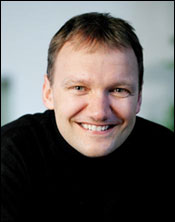
Marburg Tests Leica Nanoscope
MARBURG, Germany, March 16, 2011 — Philipps-Universität Marburg is working with Leica Microsystems on microscope technology that will provide resolution below the diffraction limit. The new optical nanoscopy, called GSDIM (ground state depletion microscopy followed by individual molecule return), is expected to make possible the imaging of subcellular structures or protein complexes far beyond the resolving powers of a light microscope, said the university’s Ralf Jacob.
The new technology, for which Leica Microsystems has been granted an exclusive license, is being tested until September in the imaging core facility of the special Cell Biology Research Department 593 in Marburg.

Cell biologist Ralf Jacob of Philipps-Universität Marburg. (Image: Leica Microsystems)
GSDIM makes it possible for researchers to image the spatial arrangement of proteins and other biomolecules in cells and to observe molecular processes. The more insight science gains into these basic processes of life, the better it can find the causes of previously incurable diseases and develop suitable therapies.
One of the strengths of the technique is that it uses conventional fluorescence markers to image proteins or other biomolecules within the cells with a sharpness down to 25 nm. This includes fluorophores that are used routinely in biomedicine.
With GSDIM, the fluorescent molecules in the specimen are almost completely switched off using laser light. However, individual molecules spontaneously return to the fluorescent state, while their neighbors remain nonilluminating. In this way, the signals of individual molecules can be acquired sequentially using a highly sensitive camera system, and their spatial position in the specimen can be measured and stored. An extremely high resolution image can then be created from the positions of many thousands of molecules. This enables cell components that are situated very close to one another and cannot be resolved using conventional wide-field fluorescence microscopy to be spatially separated and sharply reproduced in an image.
For more information, visit: www.uni-marburg.de
/Buyers_Guide/Leica_Microsystems_GmbH/c8365